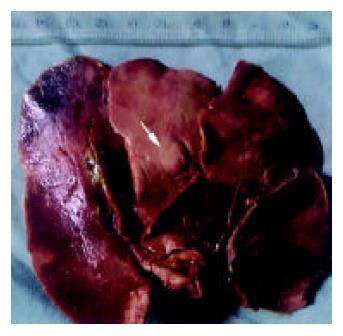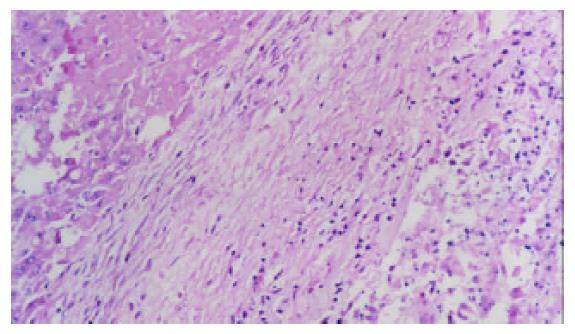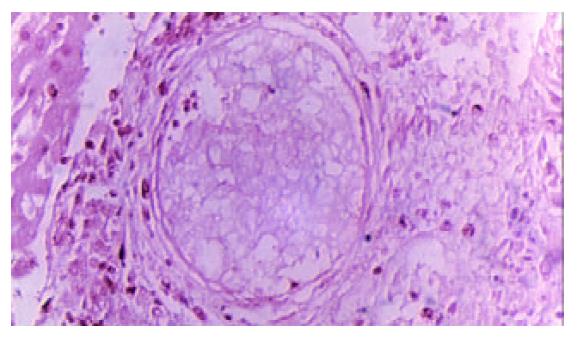修回日期: 2002-01-20
接受日期: 2002-02-07
在线出版日期: 2003-09-15
观察5-FU白芨微球经肝动脉注射对兔VX2移植性肝癌的治疗效果.
50只兔VX2移植性肝癌模型, 随机分为5组 (n = 10), 采用直视下直接穿刺血管的方法, 分别经肝动脉注入生理盐水1 mL; 5-FU溶液1 mL; 超液态碘油0.3-0.4 mL加5-FU溶液1 mL; 100 g/L白芨胶0.4 mL加5-FU溶液1 mL; 5-FU白芨微球10 mg/kg后, 观察肿瘤生长情况、坏死程度及肝功能变化等.
5-FU白芨微球栓塞后肿瘤生长受到显著抑制, 肿瘤生长率低于对照组(P < 0.01)及碘油组(P < 0.05). 肿瘤坏死以重度为主, 有2例完全坏死, 优于碘油组及白芨胶组. 但对正常肝组织损伤亦相对较重.
5-FU白芨微球具有良好的血管栓塞作用, 使用方便、安全, 是一种理想的末梢性栓塞剂.
引文著录: 李欣, 冯敢生, 郑传胜, 柳曦, 孔健. 经肝动脉注射5-FU白芨微球治疗兔VX2移植性肝癌. 世界华人消化杂志 2003; 11(9): 1337-1340
Revised: January 20, 2002
Accepted: February 7, 2002
Published online: September 15, 2003
To observe the therapeutic efficacy of 5-FU bletilla striata microspheres inFUsed through hepatic artery against rabbit VX2 transplanted hepatoma.
Fifty rabbits bearing VX2 transplanted hepatoma were randomly divided into five groups (n =10). Normal saline 1 mL, 5-Fu solutions 1 mL, ultr-liquor-lipiodol 0.3-0.4 mL and 5-Fu solutions 1 mL, 100 g/L Bletillaolloid 0.4 mL and 5-Fu solutions 1 mL, 5 FU-bletilla striate microspheres 10 mg/kg were infused though hepatic artery respectively. The tumor growth rates, necrosis rates and hepatic function were compared among the 5 groups.
5-FU bletilla striata microspheres had a very good vessel embolization function. In 5FU-bletilla striata microspheres group, the tumor was significantly inhibited, tumor growth rate was lower than tant in the control group (P <0.01) and the lipiodol group (P <0.05). Tumor necrosis grades were also more higher compared with to the other 4 groups. Complete necrosis was found in 2 of 10 rabbits in 5FU-bletilla striata microspheres group, which was more severe than that in the lipiodol group and bletillaolloid group. But the damage of normal liver tissues was also more serious.
5-FU bletilla striata microsphere is a safe and effective peripheral embolization agent.
- Citation: Li X, Feng GS, Zhen CS, Liu X, Kong J. Therapeutic efficacy of 5-FU bletilla striata microspheres infused through hepatic artery against rabbit VX2 transplanted hepatoma. Shijie Huaren Xiaohua Zazhi 2003; 11(9): 1337-1340
- URL: https://www.wjgnet.com/1009-3079/full/v11/i9/1337.htm
- DOI: https://dx.doi.org/10.11569/wcjd.v11.i9.1337
介入化疗栓塞术是治疗肝癌最有效的方法之一 [1-16], 而栓塞剂及其剂型的选择是化疗栓塞治疗的研究重点 [17-25]. 白芨是一种理想的栓塞剂 [26-32]. 我们制备了5-FU白芨微球, 并用其对兔VX2移植性肝癌模型进行栓塞化疗研究, 以期阐明该微球对肝癌的疗效及作用机制, 为其在临床的合理应用提供可靠的理论依据.
♂新西兰大白兔50只, 重量2-2.5 kg, 由华中科技大学同济医学院实验动物中心提供; VX2肿瘤细胞株由美国ATCC公司引进; 超液态碘油为法国Aulnay-sous-Bios公司产品, 5-FU注射液为上海旭东海普药业有限公司产品. 白芨胶, 5-FU白芨微球为我院药剂科制备, 制备方法及质量监控见文献 [30,31].
兔VX2移植性肝癌模型的建立参照Prat (Hepatology 1995; 21: 832)的方法并加以改进[33], 将瘤块接种于肝左外叶. 50只荷瘤兔, 随机分为5组, 每组10只, 即对照组: 经肝动脉灌注生理盐水1 mL; 5-FU组: 经肝动脉灌注5-FU溶液1 mL; 碘油+5-FU组: 经肝动脉灌注超液态碘油0.3-0.4 mL加5-FU溶液1 mL; 白芨胶+5-FU组: 经肝动脉灌注100 g/L白芨胶0.4 mL加5-FU溶液1 mL; 白芨微球组: 经肝动脉灌注5-FU白芨微球10 mg/kg. 于瘤块接种后14 d, 再次开腹, 将胃向左外完全翻出, 充分暴露肝门区后, 用自制27 G穿刺针直接穿刺肝固有或肝左动脉, 用动脉夹固定, 并暂时阻断肝右动脉血流. 造影及分别注射各组药物后, 对穿刺点局部加压止血, 逐层缝合、消毒, 动物分笼饲养. 术后1, 2, 3 wk进行CT及MR扫描, 依扫描所得瘤灶最大层面测定肿瘤的体积, 根据公式计算肿瘤生长率(growth rate, GR), GR=V治疗前/V治疗后×100 %. 术后2, 3 wk末各处死5只动物, 取肝组织, 以40 g/ L多聚甲醛固定24 h, 石蜡包埋, 每份标本分2-3 处取材, HE染色, 切片. 光镜下观察肿瘤组织坏死范围, 分为轻度(0-30%)、中度(30-70 %)、重度(70-100 %). 于术前、术后3, 7, 14, 21 d, 经耳缘静脉取血, 血样进行肝功能检查(TB、ALT). 由全自动血生化分析仪完成.
统计学处理 采用SPSS for Windows 统计软件, 对成组资料进行方差分析、组间两两比较采用Newman-keuls检验, 对计数资料作x2 检验, 均以P <0.05为有统计学意义.
5-FU白芨微球组, 栓塞后大体标本显示肝左叶可见斑片、片状局灶梗死灶, 呈苍白色, 界限清楚, 肿瘤切面可见中心明显坏死(图1). 光镜检查可见肿瘤明显凝固性坏死, 但大多数病例仍可见残余病灶, 及不同程度的出血、胆汁郁积. 瘤周可见较厚的纤维间隔, 其内可见较多炎性细胞浸润(图2). 正常肝组织亦见不同程度变性坏死, 其程度较碘油、白芨胶组栓塞组重, 肝内未见小脓肿形成. 5-FU白芨微球镜下呈半透明状, 多栓塞于小叶间动脉、微小动脉和毛细血管前微动脉水平, 栓塞血管彻底(图3). 变性、坏死区内的血管中微球多见. 被栓塞血管可出现(血管)炎性改变, 如血管壁增生、水肿, 局部有少量炎性细胞浸润, 常见继发性血栓形成, 并可见管腔闭塞. 肝窦、毛细血管、小静脉内及肺部标本未见栓塞. 但在栓塞区域门脉小分支内常可见血栓形成.
治疗前肿瘤体积差异均无显著性, 治疗后对照组兔肿瘤体积增大最明显, 5-FU白芨微球组兔肿瘤体积小于其余各组, 并有4例肿瘤体积缩小(表1). 对照组及5-FU组的肿瘤坏死程度以轻度坏死为主, 碘油组以中度为主, 兼有部分重度坏死, 白芨胶及白芨微球组则以重度坏死为主. 5-FU白芨微球组10例中, 8例见肿瘤重度明显坏死, 其中2例完全坏死, 未见存活的癌细胞, 显著大于碘油栓塞组(P <0.05). (表2)栓塞组术后ALT升高, 3 d达峰值, 然后逐渐下降, 2 wk左右降至正常, 总胆红素水平变化不明显.
| 分组 | 肿瘤体积(cm3) | 术后3 wk肿瘤增长率 (倍) | |||
| 栓塞前 | 栓后1 wk | 栓后2 wk | 栓后3 wk | ||
| 对照组 | 0.96±0.26 | 5.24±1.55 | 13.1±2.96 | 26.2±5.31 | 28±5.82 |
| 5-FU化疗组 | 0.99±0.49 | 5.22±1.96 | 11.9±2.16 | 23.1±4.76 | 25.72±8.28 |
| 碘油+5-FU组 | 0.99±0.39 | 1.95±0.27a | 3.00±1.18a | 6.66±1.98a | 6.99±1.94a |
| 白芨胶+5-FU组 | 1.00±0.31 | 1.43±0.29a | 2.14±0.88a | 4.20±1.76a | 4.27±0.99a |
| 5-FU白芨微球组 | 1.00±0.25 | 1.17±0.26ac | 1.72±1.24a | 2.84±1.69ac | 2.97±1.86ac |
中药白芨是一种集载体、栓塞、缓释及抗肿瘤作用为一体的较理想的栓塞剂[26-29], 在白芨胶的基础上, 我们进一步制备了5-FU白芨微球, 并用其对兔VX2移植性肝癌模型进行栓塞化疗研究, 以判断其疗效及机制. 兔VX2肿瘤是一种常用的富血管性肿瘤 [34-36], 我们在国内外首次采用了直视下肝动脉直接穿刺法, 此法实验成功率高, 并可在栓塞的同时阻断肝右动脉, 达到了选择性栓塞的目的, 防止了误栓, 提高了术后动物的存活率. 结果显示, 5-FU白芨微球在抑制肿瘤生长率方面显示了较好的疗效, 使肿瘤坏死更彻底, 有4例肿瘤缩小, 并有2例镜下可见肿瘤完全性坏死, 优于单纯化疗组及碘油栓塞组, 与白芨胶栓塞组相近并稍优. 但同时对正常肝脏的损伤也相对较重, 大体肝标本可见斑片, 片状坏死区, 镜下可见正常肝组织变性严重, 并见点状、灶状坏死. 术后ALT有一过性升高, 但可较快恢复.
5-FU白芨微球有良好的末梢栓塞作用, 5-FU白芨微球粒径为50-200 mm, 在栓塞后病理切片上显示其栓塞水平为肝动脉3级以下分支, 最远可达肝窦前动脉水平, 其层面在动-门脉间及肝内潜在吻合支水平以远 [27,28], 减少了栓塞后侧支循环形成的可能性. 栓塞区域门脉末梢分支内常可见血栓形成, 推测微球本身及其分解产物可能通过动-门脉间吻合支进入门脉末梢 [28,29], 起到了动-门脉双重栓塞的作用. 白芨有较强的促凝血作用, 5-FU有较强的致血管炎作用, 可刺激血管产生血管炎、继发性栓塞, 加重了栓塞程度, 延长了栓塞时间. 白芨微球具有较好的载体和缓释作用, 可维持5-FU瘤内局部高浓度, 延长药物在肿瘤内的作用时间, 与栓塞起协同增效作用. 白芨本身有一定的抗肿瘤作用, 其主要成分黏液质是一种广谱抗肿瘤成分, 对肿瘤的发生、发展均有显著的抑制作用.
与造影剂混合后, 微球悬浮性和分散性好, 不粘结, 易经小管径导管注射, 易于操作, 使用方便. 而肝窦、毛细血管、小静脉内及肺部标本中未见微球栓塞作为栓塞剂, 说明5-FU白芨微球注射后能固定于靶器官内, 没有滤过毛细血管, 造成异位栓塞. 所有动物于栓塞后均生长良好. 这些结果均说明5-FU白芨微球具有良好的生物相容性, 安全、可靠. 本研究表明, 5-FU白芨微球具有良好的血管栓塞作用, 使用安全、方便, 是一种理想的末梢性栓塞剂, 但对正常肝组织的损伤也相对较重, 故在实际应用中应注意选择适当病例, 采用超选择性插管, 尽量避免损伤正常肝组织.
| 1. | Zhang Z, Liu Q, He J, Yang J, Yang G, Wu M. The effect of preoperative transcatheter hepatic arterial chemoembolization on disease-free survival after hepatectomy for hepatocellular carcinoma. Cancer. 2000;89:2606-2612. [DOI] |
| 2. | Sangro B, Herraiz M, Martinez-Gonzalez MA, Bilbao I, Herrero I, Beloqui O, Betes M, de-la-Pena A, Cienfuegos JA, Quiroga J. Prognosis of hepatocellular carcinoma in relation to treatment: A multivariate analysis of 178 patients from a single European institution. Surgery. 1998;124:575-583. [DOI] |
| 3. | Chia-Hsien Cheng J, Chuang VP, Cheng SH, Lin YM, Cheng TI, Yang PS, Jian JJ, You DL, Horng CF, Huang AT. Unresectable hepatocellular carcinoma treated with radiotherapy and/or chemoembolization. Int J Cancer. 2001;96:243-252. |
| 4. | Fan J, Ten GJ, He SC, Guo JH, Yang DP, Wang GY. Arterial chemoembolization for hepatocellular carcinoma. World J Gastroenterol. 1998;4:33-37. [DOI] |
| 5. | O'Suilleabhain CB, Poon RT, Yong JL, Ooi GC, Tso WK, Fan ST. Factors predictive of 5-year survival after transarterial chemoembolization for inoperable hepatocellular carcinoma. Br J Surg. 2003;90:325-331. |
| 6. | Ebied OM, Federle MP, Carr BI, Pealer KM, Li W, Amesur N, Zajko A. Evaluation of responses to chemoembolization in patients with unresectable hepatocellular carcinoma. Cancer. 2003;97:1042-1050. |
| 7. | Ramsey DE, Kernagis LY, Soulen MC, Geschwind JF. Chemoembolization of hepatocellular carcinoma. J Vasc Interv Radiol. 2002;13:S211-221. [DOI] |
| 8. | Lopez RR Jr, Pan SH, Hoffman AL, Ramirez C, Rojter SE, Ramos H, McMonigle M, Lois J. Comparison of transarterial chemoembolization in patients with unresectable, diffuse vs focal hepatocellular carcinoma. Arch Surg. 2002;137:653-657. [DOI] |
| 9. | Lee JK, Chung YH, Song BC, Shin JW, Choi WB, Yang SH, Yoon HK, Sung KB, Lee YS, Suh DJ. Recurrences of hepatocellular carcinoma following initial remission by transcatheter arterial chemoembolization. J Gastroenterol Hepatol. 2002;17:52-58. [DOI] |
| 10. | Huang J, He X, Lin X, Zhang C, Li J. Effect of preoperative transcatheter arterial chemoembolization on tumor cell activity in hepatocellular carcinoma. Chin Med J (Engl). 2000;113:446-448. |
| 11. | Poyanli A, Rozanes I, Acunas B, Sencer S. Palliative treatment of hepatocellular carcinoma by chemoembolization. Acta Radiol. 2001;42:602-607. |
| 12. | Acunas B, Rozanes I. Hepatocellular carcinoma: treatment with transcatheter arterial chemoembolization. Eur J Radiol. 1999;32:86-89. |
| 13. | Rose DM, Chapman WC, Brockenbrough AT, Wright JK, Rose AT, Meranze S, Mazer M, Blair T, Blanke CD, Debelak JP. Transcatheter arterial chemoembolization as primary treatment for hepatocellular carcinoma. Am J Surg. 1999;177:405-410. [DOI] |
| 17. | Kamada K, Nakanishi T, Kitamoto M, Aikata H, Kawakami Y, Ito K, Asahara T, Kajiyama G. Long-term prognosis of patients undergoing transcatheter arterial chemoembolization for unresectable hepatocellular carcinoma: comparison of cisplatin lipiodol suspension and doxorubicin hydrochloride emulsion. J Vasc Interv Radiol. 2001;12:847-854. [DOI] |
| 18. | Chen MS, Li JQ, Zhang YQ, Lu LX, Zhang WZ, Yuan YF, Guo YP, Lin XJ, Li GH. High-dose iodized oil transcatheter arterial chemoembolization for patients with large hepatocellular carcinoma. World J Gastroenterol. 2002;8:74-78. |
| 19. | Ueno K, Miyazono N, Inoue H, Nishida H, Kanetsuki I, Nakajo M. Transcatheter arterial chemoembolization therapy using iodized oil for patients with unresectable hepatocellular carcinoma: evaluation of three kinds of regimens and analysis of prognostic factors. Cancer. 2000;88:1574-1581. [DOI] |
| 20. | Kamada K, Kitamoto M, Aikata H, Kawakami Y, Kono H, Imamura M, Nakanishi T, Chayama K. Combination of transcatheter arterial chemoembolization using cisplatin-lipiodol suspension and percutaneous ethanol injection for treatment of advanced small hepatocellular carcinoma. Am J Surg. 2002;184:284-290. [DOI] |
| 21. | Koda M, Murawaki Y, Mitsuda A, Oyama K, Okamoto K, Idobe Y, Suou T, Kawasaki H. Combination therapy with transcatheter arterial chemoembolization and percutaneous ethanol injection compared with percutaneous ethanol injection alone for patients with small hepatocellular carcinoma: a randomized control study. Cancer. 2001;92:1516-1524. |
| 22. | Seki T, Tamai T, Nakagawa T, Imamura M, Nishimura A, Yamashiki N, Ikeda K, Inoue K. Combination therapy with transcatheter arterial chemoembolization and percutaneous microwave coagulation therapy for hepatocellular carcinoma. Cancer. 2000;89:1245-1251. |
| 23. | Komemushi A, Tanigawa N, Okuda Y, Kojima H, Fujii H, Shomura Y, Sougawa M, Sawada S. A new liquid embolic material for liver tumors. Acta Radiol. 2002;43:186-191. |
| 26. | Feng G, Kramann B, Zheng C, Zhou R. Comparative study on the long-term effect of permanent embolization of hepatic artery with Bletilla striata in patients with primary liver cancer. J Tongji Med Univ. 1996;16:111-116. |
| 27. | Zheng C, Feng G, Zhou R. New use of Bletilla striata as embolizing agent in the intervention treatment of hepatic carcinoma. Zhonghua Zhongliu Zazhi. 1996;18:305-307. |
| 28. | Zheng CS, Feng GS, ZhangYF . Bletilla colloid as a vascular embolization agent: experimental studies. Chin J Radiol. 1998;32:188-191. |
| 29. | Zheng C, Feng G, Liang H. Bletilla striata as a vascular embolizing agent in interventional treatment of primary hepatic carcinoma. Chin Med J (Engl). 1998;111:1060-1063. |
| 30. | Li WY, Du DM, Feng GS, Chen HT. Preparation of Bletilla striata microspheres and experimental study on embolization of hepatic artery in pigs. Acta Univ Med Tongji. 1999;28:62-65. |
| 31. | Li WY, Feng GS, Zheng CS, Zhen Y. Pharmacokinetics of 5-Fu Bletilla microspheres following renal arterial embolization in rabbits. Acta Univ Med Tongji. 2001;30:501-502. |
| 32. | Feng GS, Li X, Zheng CS, Zhou CK, Liu X, Wu HP. Mechanism of inhibition of tumor angiogenesis by Bletilla colloid: an experimental study. Chin Med J. 2003;83:412-416. |
| 33. | Prat F, Centarti M, Sibille A, Abouel-Fadil FA, Henry L, Chapelon JY, Cathignol D. Extracorporeal high-intensity focused ultrasound for VX2 liver tumors in the rabbit. Hepatology. 1995;21:832-836. |
| 34. | Boehm T, Malich A, Goldberg SN, Reichenbach JR, Hilger I, Hauff P, Reinhardt M, Fleck M, Kaiser WA. Radio-frequency tumor ablation: internally cooled electrode versus saline-enhanced technique in an aggressive rabbit tumor model. Radiology. 2002;222:805-813. [DOI] |
| 35. | Tabaru K, Konno T, Oda T, Nagamitsu A, Ishimaru Y, Kitamura N. Treatment of VX2 carcinoma implanted in the liver with arterial and intraperitoneal administration of oily anticancer agents. Cancer Chemother Pharmacol. 2001;47:149-154. [DOI] |
| 36. | Hamuro M, Nakamura K, Sakai Y, Nakata M, Ichikawa H, Fukumori Y, Yamada R. New oily agents for targeting chemoembolization for hepatocellular carcinoma. Cardiovasc Intervent Radiol. 1999;22:130-134. [DOI] |











